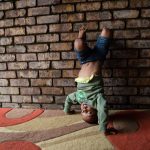Text Messages | Recommended reading for young adults
That books are the answer goes without saying but South Africa’s schools are struggling to provide amenities and a basic education, never mind quality reading material.
Author:
18 July 2019

Of the many legacies that he left, former president Nelson Mandela arguably might have been most pleased by his work for children. The foundation that bears his name carries that work forward, but in a forbidding environment.
South Africa’s children are on the whole not well served by the education and educational facilities available to them. Schools in South Africa’s cities and towns often have broken plumbing and sanitation; in rural areas, they have no sanitation at all. And despite the heartbreaking cases of young schoolgoers dying after falling into pit latrine toilets in rural schools, the situation remains unresolved.
Facilities at schools aside, education in schools is also problematic. South African children have low numeracy and literacy skills that means they will be massively disadvantaged in the job market locally and all but excluded from it globally. How can this be?
Related article:
Educators are fond of emphasising that parents need to partner in the education of their children by working with them on homework and reading to them when they are younger. Parents aren’t always able to help their children with schoolwork, even when they have the time. Nor is reading to their children an easy option because of factors such as time and language.
But that reading is close to a panacea is beyond doubt. Reading opens up new worlds and ideas, new people and things. Reading enlarges and enthuses. Placing demands on imagination and logic, reading is worlds away from the passivity that television demands and induces. Whereas television is a force-feeding mechanism, pouring spectacle and “entertainment” into viewers’ eyes and down their throats, reading invites the reader to co-imagine and even to co-author the story.
Recommended reading
Early reading of a wide range of stories and books is vitally important. A reading list for 12 to 13-year-olds in “middle school” at Manhattan Country School in New York, United States, yields a remarkable collection of titles, which looks at race, class, gender, migration, LGBTQIA+ issues, the environmental emergency and speculations about the future. The following books represent some of the list.
- They Call Me Güero: A Border Kid’s Poems by David Bowles is about Harriet, lonely and seemingly abandoned by friends away on summer camp and by parents who work all day. She resorts to an age-old device, the diary, and this drawing on her creative powers helps in her loneliness and in dealing with some other, larger problems (no spoiler alerts here!).
- Fly Girls: How Five Daring Women Defied All Odds and Made Aviation History (Young Readers Edition) by Keith O’Brien. All right, this is a story about women written by a man, but that doesn’t invalidate its theme. O’Brien tells the story of how five women challenged the male hegemony in the sport of aeroplane racing in the US between World War I and II. The women came from a wide range of backgrounds and occupations: Amelia Earhart, destined to become the most famous of the five; Ruth Elder, an Alabama “housewife”; Florence Klingensmith, a dropout from high school; Ruth Nichols, the daughter of a Wall Street dynasty; and Louise Thaden, whose beginnings were as a coal-seller in Wichita, Kansas.
- Boy Oh Boy: From Boys to Men, Be Inspired by 30 Coming-of-age Stories of Sportsmen, Artists, Politicians, Educators and Scientists by Cliff Leek. This collection presents what are billed as “30 positive male role models from throughout history. From activists like Mahatma Gandhi and Frederick Douglass to creative innovators like Prince …”.
- Dragon Pearl by Yoon Ha Lee. This belongs to the so-called space opera genre of science fiction, and is a sophisticated read for the age group that the reading list targets. (Adult friends who are science fiction and fantasy, or SFF, aficionados have lavished praise on Dragon Pearl.) In one line, the story follows its 13-year-old protagonist Min, who is descended from a long line of fox spirits, an ethereal character type much loved in Japanese and East Asian folklore, mythology, legend and literature.
So much for a glimpse of a reading list from another education system. If only ours could suggest books to read in the knowledge that the readers will have a proper environment in which to read.

